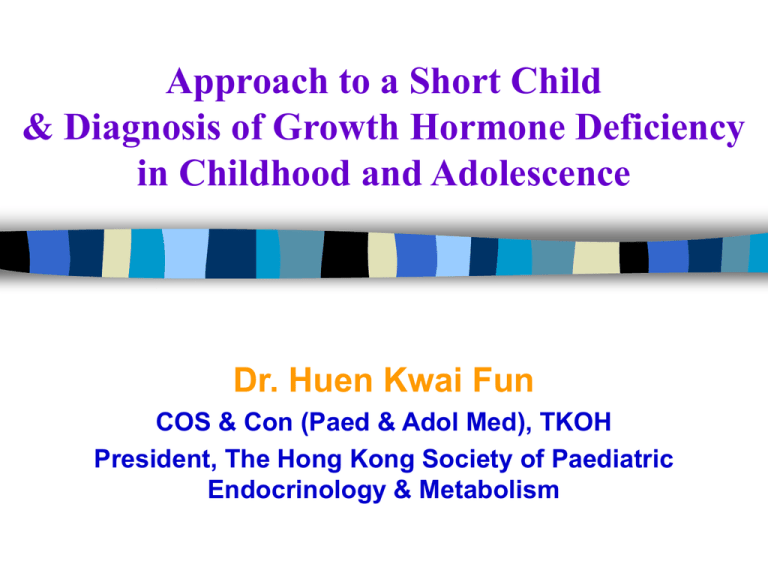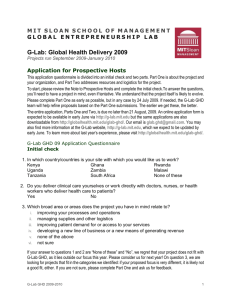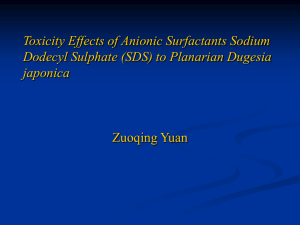
Approach to a Short Child
& Diagnosis of Growth Hormone Deficiency
in Childhood and Adolescence
Dr. Huen Kwai Fun
COS & Con (Paed & Adol Med), TKOH
President, The Hong Kong Society of Paediatric
Endocrinology & Metabolism
Prevalence of IGHD
UK, Germany, France – 18-24 per million
Sweden – 62 per million
US – 287 per million
Guyda HJ. TEM. 5(8):334-40
Differences in diagnostic criteria –
inclusion for Rx of less severe forms of
IGHD
Worldwide Indications for GH Px
Canada – Only approved for classical GHD
Dx with strict criteria
Ht and GV < -2SDS and peak GH <5 ug/L
(before 1983) or <8 ug/L (after 1983) after
ITT, arginine, or combined L-dopapropanolol testing on 2 separate occasions
Japan, Sweden, France - Approved for
Turner Syndrome also
USA - Approved for CRF also
Australia – approved use of GH for all
short children who meet only auxological
criteria without regard to GH secretory
status
1988 – Ht < 3% and GV < 25%
1994 – Ht < 1% and GV < 25%
(OZGROW study)
(comprehensive national database + small
no prescribers + tight audit system)
FDA approved indications: GHD, CRI,
Turner syndrome, SGA, Prader-Willi
syndrome, idiopathic short
History
Birth weight
– SGA baby may remain small with no catch up
Neonatal history
– Hypoglycaemia, micropenis, prolonged jaundice,
craniofacial midline abn, cong nystagmus may
indicate congenital GHD and panhypopituitarism
– Maternal drug exposure
Parents’ height
– Calculate mid-parental height:
(mother’s ht + father’s ht 13cm) 2 5cm
– Genetic short stature / hereditary skeletal
dysplasia as causes
Heights of siblings
Pubertal history of parents:
– Age of menarche of mother
– History of late bloomers for father
– +ve FHx of pubertal delay may indicate
Constitutional growth delay
Past growth history, growth velocity and
when falling off is first noticed
– Normal GV usually ~5cm/yr (4-10yrs)
– Children with constitutional growth delay may
demonstrate fall off growth between 3m to 2yrs
and then grow along that percentile until puberty
Detail nutritional history
– Poor dietary intake may indicate nutritional
dwarfism as cause
Detail psycho-social history
– May indicate emotional deprivation as cause
Past health
– Any chronic illnesses may result in poor growth
Dental history
– Late teeth eruption may suggest pubertal delay
Drug history: especially glucocorticoids
Physical Examination
Height, weight and HC
Weight to height ratio
Arm span
– Increased vs body height in patients with
short axial skeleton (skeletal dysplasia) or
long extremities (Marfan’s syndrome)
Sitting height
– Measured using sitting height table / stool,
with upper surface of thighs horizontal, feet
supported and back of knee just clear of stool
– Lower segment can also be measured by
length between public symphysis to heel
Upper segment / lower segment ratio
– Sitting ht (standing ht – sitting ht)
– Normal ratio: ~1.4 under 4yr, ~1.2 at 10yr,
~1.1 during puberty
– Short limbs: achondroplasia,
hypochondroplasia, multiple epiphyseal
dysplasia
– Short trunk: mucopolysaccharidoses,
spondyloepiphyseal dysplasia
Dysmorphic features
– Turner’s syndrome
• Must be considered in any girls with short stature, may
have no obvious features in Mosaic Turner’s
• Dysmorphic features: cubitus valgus, low hair line,
shield like chest, hypoplastic nails
• Hints: raised baseline FSH and LH in girls after 9-10yr
– Russell-Silver syndrome
• Clinical features: IUGR, hemihypertrophy, triangular
facies and clinodactyly
– Other syndromes: Seckal, Noonan, Prader-Willi
Pubertal development
Systemic examination of all systems
– To exclude chronic illness and hypothyroidism
Genetic Short Stature
One or both parents and often
grandparents short
Ht after age 2 correlated well with final ht
Short throughout childhood
GV normal, grow // to and often just < 3%
BA ~ CA
PAH short normal
Final ht near target ht
Constitutional Growth Delay
Parental ht normal
Hx of delay maturation of parents
Slow GV, ht gradually deviate from normal
curve until puberty
Delay BA and sexual development
PAH in normal range
Evaluation of short stature
Ht just < -2 SDS, GV > 5 cm/yr (age 3 -10) –
just monitor growth
Ht -2 SDS to -3 SDS, GV normal –
FBC,ESR, urinalysis, R/LFT, TFT, BA
Ht < -3 SDS or abn GV – further endocrine
and systemic work up
Indications for further investigations
Current height percentiles not compatible with
genetic potential
Demonstration of deceleration of growth by
crossing one percentile (> 2 yrs)
>3 SD below the mean height for age
Subnormal growth velocity for age
(Refer endocrinologists for further evaluation and work up)
Further investigations
GH assay: considered normal GH reserve if peak
GH response to stimulation 15mIU/L in any 1 test
For IGF-1, IGF-BP3 and genetic study if
– Persistent subnormal growth velocity
– Significantly short children (>3SD below mean
height for age)
– High baseline GH suggestive of GH resistance
X ray long bones and genetic study for
disproportionate short stature due to skeletal
dysplasia
Follow up and Management
Follow up once every 4-6 months if a firm diagnosis
is made with a normal GH response
Improve dietary intake if inadequate diet
Explain height potential if genetic short stature and
constitutional growth delay and reassure parents
Prepared by Dr. Elaine Kwan
References:
Short stature and GHD. Clin Endo 1995; 43:133-42
Pediatric decision making. Berman
Clinical Paediatric Endocrinology. Kaplan
Importance of Diagnosis of GHD
1. Identify children most likely to benefit from many
years of GH Rx before initiation
Children uniformly benefitted most in all published series those identified to have GHD utilizing classical criteria
Use of inadequate Dx criteria for GHD in childhoood resulted in
a significant no (40-67 %) having a normal GH result upon
retesting after discontinuation of GH Rx in adults
(Longobardi S et al. JCEM 81:1244-7; Tillmann V et al. JCEM 82: 531-5;
Tauber M et al. JCEM 82:352-6; Maghnie M et al. JCEM 84: 1324-8)
Canada – strict Dx criteria - retested – high true +ve rate of
95% in childhood onset due to organic causes and 91% in
idiopathic GHD (Reyes L et al.)
2. Identify children w profound GHD – frequently
ass w MPHD that must be Dx and Rx
3. Identify GHD ass w CNS tumors
4. The ethics, economics, and potential Cxs related
to use of GH Rx esp w high dosages
Consensus Guidelines for the Dx and Rx
of GHD in Childhood and Adolescence
Summary Statement of the GH Research Society
Endorsed by:
European Society for Pediatric Endocrinology
Lawson Wilkins Pediatric Endocrine Society
Australasian Pediatric Endocrinology Group
Japanese Society for Pediatric Endocrinology
Sociedad Latinoamericana de Endocrinologia
Pediatrica
GH Research Society JCEM 2000; 85 (11) : 3990-3
Consensus
In absence of a clearly defined benefit (auxological
or psychological), use of GH for children w normal
GH secretion is not supported.
Despite limitations, it is indeed possible to
accurately assess GH-IGF axis in majority of short
children, and, further, to make a Dx of ‘classical’
GHD, using a combination of auxological criteria
and biochemical assessments.
GH Research Society. JCEM 2000; 85 (11) : 3990-3
Entry into this evaluation process should be
reserved for the slowly growing child w a
significantly decreased GV. Rosenfeld RG JCEM 1995; 80(5):1532-40
Diagnosis of GHD
GHD part of a spectrum of growth disorders,
continuum in all parameters
No observations or tests absolutely reliable
Clinical and Auxological evaluation
Biochemical assessment
Radiological evaluation
Genetic work-up
Best judgement of an experienced clinician
Stress on considering all available information in
reaching a conclusion. The appropriate focus is
on the pt and not on any particular set of nos.
Clinical & Auxological Criteria
Short stature is defined as ht < -2 SDS or < 3%
2.5% – 3% at extreme end of distribution – normal
GV < 25 % ( <5 cm/yr age 3-10)
Require updated population standard and longitudinal
velocity standards
? Expressed in SDS rather than in percentiles
-3 SDS or 0.1 % should be included
Use of Ht % and GV in cm/yr – ?deserve a place in def
Body composition, bone density and bone markers –
presently not discriminatory for Dx of GHD
Advantages - Noninvasive and inexpensive
Probably defines the population at risk
Pitfalls - Not distinguish pts w GHD and those w ISS
Does not predict response to GH Rx
Criteria for immediate Ix
1.
2.
3.
4.
5.
6.
7.
Severe short stature – ht < -3 SDS
Ht < -1.5 SDS mid-parental ht
Ht < -2 SDS and GV over 1 yr < -1 SD, or
decrease in Ht SDS >0.5 over 1 yr (>2 yr old)
In absence of short stature, GV < -2 SDS over 1
yr or < -1.5 SDS sustained over 2 yr
Signs indicative of intracranial lesions
Signs of MPHD
Neonatal S/S of GHD
Consensus Guidelines by GH Research Society. JCEM 85(11):3990-3
Radiological Evaluation
Bone age
Lateral SXR
MRI
Up to 80% pts labeled as IGHD has defined
diagnostic markers
>50% isolated GHD have PSIS
Pituitary Stalk Interruption Syndrome (PSIS) –
lack of a visible or an interrupted pit stalk,
ant pit hypoplasia, and
lack of normal post lobe hypersignal in sella
turcica, w an ectopic hyperintense post pit
Evaluation for genetic disorders
Tests for genetic mutations (e. g. PROP1 and
POU1F1) only available in research lab
Pointers to genetic disorders:
Early onset of growth failure
+ve FHx and possible consanguinity
Ht > 3SD below the mean
Extremely low GH response to provocation tests
Very low IGF-1 and IGFBP-3 levels
1.
2.
3.
4.
5.
Biochemical assessment
Limitations of conventional methodologies:
1. GHD and normal short stature not cleanly
demarcated entities. Evidence of overlap of all
auxological and biochemical parameters
2.
GH secretion is a continuous spectrum.
Criteria for abnormal response is only arbitrary.
Loosening of Dx cut-off from 5-7 to 10 ng/ml,
based on no physiological data
3.
No satisfactory mechanism to resolve
conflicting data from 2 or more tests.
The commonly employed paradigm of requiring
failure on 2 provocative tests does not address the
simple question of 2 out of how many?
4.
Lack of age- and puberty-related (? sex steroid
priming) normal data to define threshold for
subnormal IGF-1 and IGFBP-3 levels and GH
responses to provocative test
5.
Application of a single fixed cut-off level for
GHD independent of the provocative test in use
6.
Poor reproducibility of GH provocative tests or
spontaneous GH profiles
7.
Provocative testing is nonphysiological.
Such tests clearly do not replicate normal secretory
dynamics
8.
Great interassay variations in GH
radioimmunoassays. Presumably reflecting
variability in molecular forms of GH among pts, use
of polyclonal vs monoclonal Ab, and employment of
different diluents and standards.
9.
Provocative GH testing ass w significant cost,
discomfort to pt, and some risk. Deaths occurred
during ITT and arginine stimulation tests
10.
Impact of obesity and depression on GH
provocative testing not properly addressed
11.
Demonstration of normal response does not
exclude various forms of GH insensitivity
Practical assessment of GH status
1.
24-h spontaneous GH profiles –
impractical. Not more reliable (both
sensitivity & specificity) than standard
provocative tests
2.
GHRH tests + arginine or pyridostigmine
(suppress somatostatin) –
best GH stimulation but unable to detect
GH insufficiency ass w hypothalamic
dysfunction(most common cause of GHD)
3.
Urinary GH estimation – not useful,
great inter- and intra- variability
4.
Growth factor measurements
IGF-1 & IGFBP-3
More reproducible, longer half-lives, little diurnal
variation. Acceptable sensitivity and specificity
No age- , sex- and puberty - related standards
Unreliable <5 yrs. Discriminate better >8 yrs
Higher levels in CNS tumors and radiationinduced GHD
Hintz: Paed 102(2) Aug 1998:524-6
IGF-1 or IGFBP-3 > -1 SDS essentially rules out
classic GHD. Practical application – exclude pts
unlikely GHD and identify pts further work up
should be performed
JCEM 1996;81:1927-32
Pitfalls –
cannot discriminate completely GHD and short
normal; cannot predict long-term response to GH
DDx of IGF deficiency
1.
2.
3.
4.
5.
6.
GHD due to hypothalamic dysfunction
GHD due to pit dysfunction
GH insensitivity (GHI)
A. Primary GHI
a. GH receptor def –mutations/deletions
b. Abn GH signal transduction – post-receptor
B. Secondary GHI
a. malnutrition
b. hypothyroidism
c. chronic ds – liver ds, DM, infection
d. drugs- chemoPx, steroids, psychotropic drug
Primary defects of IGF synthesis
Primary defects of IGF transport/clearance
IGF resistance
5.
Most information gained by single
IGF-1 and IGFBP-3 estimation +
single dynamic provocative test
(N) IGF-1 + IGFBP-3 + (subN) peak GH
response – 2nd test help to distinguish
GHI and normal short
GH Provocation tests
Age- and sex-defined N data
Standardized GH assay -An assay that measures 22kDa hGH, using monoclonal Ab recommended
Appropriate GH cut-off w recent lab advances
Limit no. of provocative agents w well
standardized protocol
Great care exercised in using insulin or
glucagon in a young child
Sex steroid priming indicated in immediate
peripubertal period
2 tests in suspected GHD (sequential or on
separate days). One test w defined pathology
New approaches to improve Dx accuracy of GH
testing by both endogenous GHRH stimulation
and somatostatin inhibition -> augmented and
more reproducible peak GH response
GH provocation tests
IH – 0.1 IU/kg IV; GHRH stimulation;
hypoG Sxs; GH 0-120 min
ARG – 0.5 g/kg infusion; somatostatin
inhibition; vomiting 2%; GH 0-120 min
CLO – 2 mcg/kg po; GHRH stimulation;
mild somnolence 35%; GH 0-180 min
L-DOPA – 125mg, 250mg, 500mg po for
BW <15, 15-30, >30 kg; GHRH stimulation;
vomiting 25%; GH 0-180 min
GLU – 15 mcg/kg, max 1 mg IM; GHRH
stimulation; vomiting 15%; GH 0-180 min
GHRH – 1 mcg/kg IV; facial flushing 30%;
GH 0-90 min
Pyridostigmine – 60 mg po; somatostatin
inhibition; mild abd pain; GH 0-180 min
GHRH + ARG/ PD – max somatotrope
stimulation
Propanolol – 0.5 mg/kg, max 40 mg; 1h
before test to augment primary stimulus
response
Dx of GHD
Ht < - 3 SDS
GV < 25 %
Delayed bone age (< -2 SDS)
PAH substantially < mean parental Ht
(< -1.5 SDS)
IGF1 and IGFBP3 < -1 SDS
Impaired peak GH response to 2
provocation tests
+/- MRI or genetic abnormalities
Thank You










